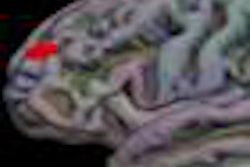
In this era of healthcare cost control, is there a better way to use MRI for patients with headache? There might be: Researchers have found a protocol that eliminates MRI sequences that are potentially unnecessary for diagnosis, according to a new study published in the July issue of the American Journal of Roentgenology.
A team led by Dr. Aseem Sharma from the Mallinckrodt Institute of Radiology investigated whether a two-part approach to MRI use for patients with headache could be a viable, cost-effective alternative to conventional MRI. Patients would proceed to comprehensive MRI only if results from an initial scan acquired using a fluid-attenuated inversion recovery (FLAIR) pulse sequence showed it would be helpful. The FLAIR sequence is a technique that cancels out fluids on an MR image.
 Dr. Aseem Sharma from the Mallinckrodt Institute of Radiology.
Dr. Aseem Sharma from the Mallinckrodt Institute of Radiology.
MRI usually requires acquisition of multiple sequences that provide complementary information. Some patients with underlying disease definitely benefit from multiple sequences, but many of these may be unnecessary in other straightforward situations, Sharma's group wrote. If a particular MRI sequence could identify the subgroup of patients likely to benefit from additional imaging sequences, perhaps it could allow for more efficient utilization of scanner time, potential cost reduction, and less burden on patients (AJR, July 2013, Vol. 201:1, pp. W75-W80).
"We noticed through reading a bunch of studies that the FLAIR sequence was the most helpful for us with patients with headache," study co-author Dr. Martin Reis, of St. Louis Children's Hospital, told AuntMinnie.com. "We wanted to explore whether, if we just looked at the FLAIR sequence on exams taken for patients with headache, we would miss significant findings that you see on a complete brain MRI. The goal was to see if we could streamline and make things even more efficient without sacrificing accuracy."
The team included data from 245 patients with headache who had MRI studies between October 2009 and July 2011. Three radiologists used the FLAIR pulse sequence from these exams to diagnose an underlying abnormality or to determine the need for a comprehensive MRI study. Sharma's group then compared the diagnostic efficacy and cost implications of this two-part approach with conventional MRI from the perspectives of payors, patients, and imaging facilities.
Twenty-four patients were found to have disease, according to the authors. The two-tiered approach had a sensitivity of 83.3% and a specificity of 100%, which did not significantly differ from the sensitivity of 91% and specificity of 97.8% for the conventional approach. Assuming a 50% reduction in payment for the initial MRI performed as a first step of the two-tiered approach, this model would have resulted in 44.8% savings to the payor, the team found.
 Dr. Martin Reis from St. Louis Children's Hospital.
Dr. Martin Reis from St. Louis Children's Hospital.
Sharma and colleagues estimated that MRI scanner use time would drop dramatically -- from 4,168 minutes to 1,249 minutes -- if the two-tiered approach were used. Although 11% of patients in the study would have been recalled for comprehensive MRI, the average time spent in the scanner by each patient would have been less with the two-tiered approach, at 5.1 minutes, compared with 17 minutes for conventional MRI.
How would this two-tier protocol affect reimbursement? The study was conducted under the assumption that the professional component of reimbursement for the initial, shorter MRI exam wouldn't be changed, the authors wrote. But even if reimbursement was reduced, the decrease could be offset by the increased throughput made possible by the two-tier approach.
The effort to manage imaging costs has focused on curbing overutilization by reducing inappropriate tests, Sharma's group wrote: In fact, headache is one of the symptoms for which the American College of Radiology (ACR) has recommended against routine imaging as part of the Choose Wisely campaign.
"It's controversial whether patients with uncomplicated headache should be imaged in the first place," Reis told AuntMinnie.com. "MRI scanner time is precious, and we want to figure out a way to use it as efficiently as possible, both for the benefit of the patient and the radiology department."




.fFmgij6Hin.png?auto=compress%2Cformat&fit=crop&h=100&q=70&w=100)




.fFmgij6Hin.png?auto=compress%2Cformat&fit=crop&h=167&q=70&w=250)











